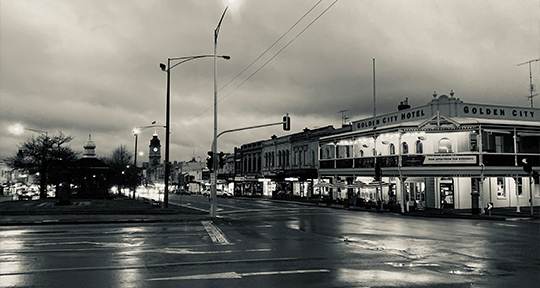Studio 09
postcode 3350 : change (in) the centre
Ammon Beyerle

Studio Description
WHAT does urban regeneration mean in a regional city? / WHAT does adaptive reuse for residential intensity look like? / WHAT actions can architect’s take to change a city centre for living? / HOW might living in the centre change how people live? / HOW might living architecture support and catalyse how people change?
Agency, Agonism, and Difference in architecture + urban design, will be the operative terms in this studio about accommodating and actively encouraging new types of living in the centre of an existing regional city – long neglected, now ripe for new ecologies of change.
Ballaarat – the capital of Western Victoria has very little inner-city housing – whether it be medium density, grey-field, infill, adaptive, hybrid, mixed or otherwise, the number of dwellings in the centre has been low for decades. Where Ballarat has great bones, deep history, a beautiful geographical setting, broad boulevards and intricate laneways, the centre still maintains relatively low land costs and proliferates empty shop-tops, warehouses, and on-grade parking lots. Real estate is booming whilst fringe development is proliferating, dis-integrating community, destroying the natural environment, and drying up the economy for a thriving civic centre.
In the early 1990s, City of Melbourne’s Postcode 3000 - Action Plan for City Living, transformed how people thought about central Melbourne, as a place to live.
Forward to the 2020s, this studio imagines City of Ballarat’s Postcode 3350 – seeking to develop inspiring case studies for action. We will engage in the mess of bins, fire egress, accessibility, and political space. Set at the cusp of change, Ballarat is now one of the fastest growing cities in Victoria, led by public and private investment, the Ballarat 2040 Strategy, an upgraded 59min train-ride to Melbourne, a new 1000-job GovHub and library Civic Hall Site, the Creative Ballarat Strategy, and rush to the regions post COVID19.
Studio Outcomes
Students will work in groups and individually to identify key sites and urban types for adaptive reuse and new-build projects, eventually developing and testing individual design approaches at multiple scales – large, medium, small in detail. Where the goal will be a thesis including multiple case studies, students will engage with the reality of urban fabric – built and un-built heritage – to design architecture buildings and the processes of architecture. A critical engagement with urban regeneration will be required and we will draw on theories of participation / placemaking, power / empowerment, gentrification / creativity, and reciprocity.
Studio Leaders
Dr Ammon Beyerle is a registered architect and director of Here Studio, an architectural practice of sustainability activists in central Victoria. Here Studio is focused on “participatory design” of community projects, and residential “affordable everyday architecture”, and have undertaken a number of challenging public transformation projects. Ammon completed a PhD titled “Architecture and Participation: agonism in practice”, supervised by Karen Burns and Kim Dovey – studying architecture and language at the University of Melbourne, (and Paris-Val-De-Seine, and T-U Berlin). Ammon has taught architecture, landscape architecture, construction technology and urban design since 2005, focussing on sustainability, adaptive reuse, medium-density housing and public space.
Readings & References
- Bishop, (2006) Participation.
- Bourriaud, (2002) Relational Aesthetics.
- DeLanda, (2005) Space: extensive and intensive, actual and virtual.
- Dovey, etal, (2014) “Density without Intensity” and “Public/private urban interfaces”; etal, (2018), Mapping Urbanities
- Edensor, (2006) “The Culture of the Indian Street”.
- Franck, etal, (2006) Loose Space: Possibility and Diversity in Urban Life
- Gehl, (1987) Life Between Buildings; (2010) Cities for People.
- Guattari, (1992). Chaosmosis; (1989) The Three Ecologies.
- Hinkel, ed., (2011). Urban Interior: Informal explorations, interventions and occupations.
- Jacobs, (1961) “The Uses of Sidewalks”.
- Kingwell, etal, (2009) Rites of way: the politics and poetics of public space.
- Latour, (2005) Reassembling the Social.
- Lefebvre, (1968) The Right to the City.
- Miessen, and Mouffe, (2008) “Violating Consensus”.; and Basar, eds., (2006) Did Someone Say Participate?
- Newman, (1992) “The Compact City”
- Sennett, (1970). The Uses of Disorder.
- Soja, (1996). Thirdspace.
Schedule Tuesdays and Fridays 15:15-18:15